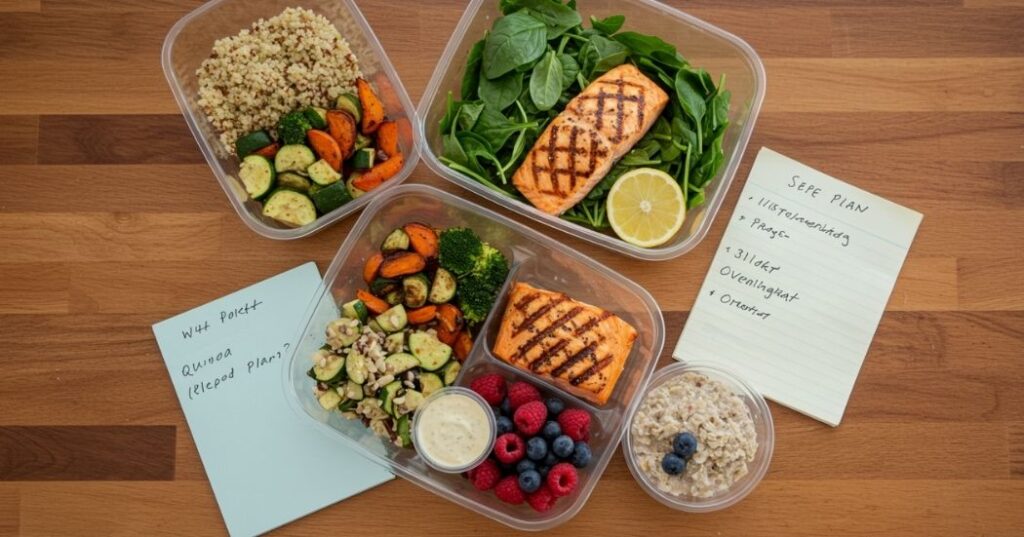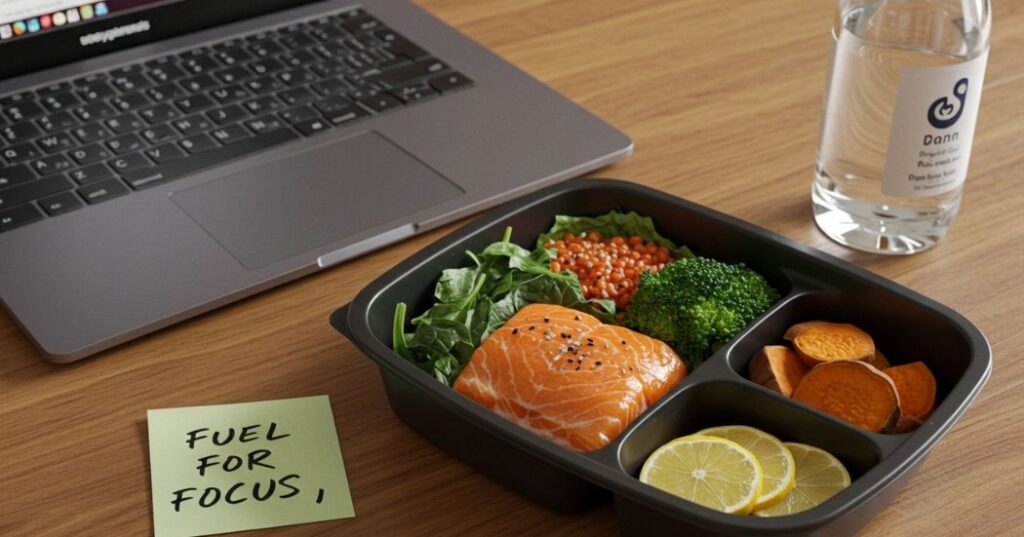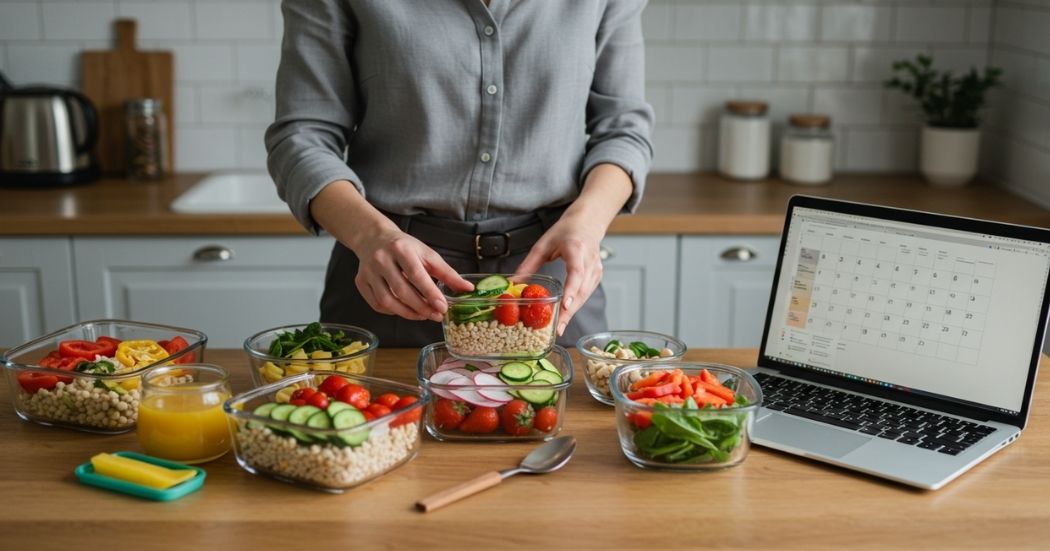Tired of Last-Minute Meals? Master the Art of Efficient, Energizing Meal Prep

Between relentless meetings, looming deadlines, and the constant demands of family life, prioritizing healthy eating often feels like an impossible task, quickly falling off your already overflowing to-do list. But here’s the truth that busy professionals often overlook: a little strategic prep now can save you countless hours (and a significant amount of stress) later in the week.
These comprehensive meal planning strategies for busy professionals are meticulously crafted to fit seamlessly into your packed schedule—whether you’re navigating a hybrid work model, commuting daily, or juggling a demanding side hustle. Get ready to transform your eating habits, reclaim your time, and enjoy delicious, nutritious meals without the daily scramble.
🗓️ 1. Set Your Meal Planning Routine (Just 30-60 Minutes Weekly)

The first step to successful meal planning isn’t about cooking; it’s about scheduling. Decision fatigue is real, and by planning your meals just once a week, you’ll save yourself from countless last-minute, often unhealthy, food choices later on. This single commitment of 30-60 minutes can genuinely save you hours of stress, grocery store trips, and cooking time throughout the week.
- Choose Your Planning Day: Dedicate a specific time each week. For many busy professionals, Sunday morning or Friday night works best. Find a quiet half-hour when you can focus without interruption.
- Utilize a Planning Tool: Whether you prefer digital or analog, pick a tool that suits you. Options include dedicated meal planner apps like PlanToEat or Paprika, a simple spreadsheet in Google Sheets or Excel, or even a classic pen-and-paper planner. The key is consistency with your chosen method.
- Start with Dinners First: Dinners often require the most thought and preparation. Plan these first, then consider how leftovers can be repurposed for lunch. Finally, fill in easy, repeatable options for breakfasts and snacks.
- Build a “Go-To” Meal Bank: Compile a list of 10-15 healthy, quick, and easy recipes that your household enjoys and that you can prepare efficiently. This “meal bank” becomes your secret weapon, allowing you to quickly rotate through familiar options without constantly searching for new ideas.
Pro Tip: Consider themes for dinner (e.g., Meatless Monday, Taco Tuesday, Fish Friday) to simplify decision-making.
🛍️ 2. Shop Smarter with a Category-Based Grocery List
An organized grocery list isn’t just about efficiency; it’s about preventing impulse buys and ensuring you have everything you need for your planned meals. Organizing your list by store section can drastically cut down your shopping time and prevent forgotten items.
- Organize by Store Aisles: Structure your list by categories that mirror a typical grocery store layout. This means less backtracking and faster navigation. Common categories include:
- Proteins: Chicken breast, tofu, eggs, ground turkey, salmon, Greek yogurt.
- Produce: Leafy greens (spinach, kale), berries, onions, garlic, apples, carrots, bell peppers, broccoli.
- Grains & Legumes: Quinoa, oats, brown rice, whole-wheat pasta, canned beans, lentils.
- Dairy/Alternatives: Almond milk, unsweetened yogurt, cheese.
- Pantry Staples: Olive oil, spices, vinegars, canned tomatoes, chicken/vegetable broth.
- Frozen: Frozen fruits, vegetables, lean protein options.
- Leverage Digital Tools: Utilize grocery list apps like AnyList or Out of Milk. These apps often allow you to create recurring lists, share with family members, and even reorder items based on your usual shopping patterns.
- Shop Online/Curbside Pickup: For maximum time-saving, explore online grocery ordering for pickup or delivery. This eliminates the physical trip entirely.
Bonus Tip: Check your pantry and fridge before making your list to avoid duplicates and reduce waste.
🍱 3. Batch Cook & Portion Like a Pro
This is the cornerstone of meal planning for busy professionals. Dedicate a specific block of time (e.g., 2-3 hours on Sunday) to prepare components or entire meals in larger quantities. One focused cook session can yield healthy, ready-to-eat meals for several days, eliminating daily cooking stress.
- Batch Prep Ideas for Efficiency:
- Protein Powerhouse: Grill or bake a large batch of chicken breast, lean ground turkey, or roasted tofu. This versatile protein can be used in salads, wraps, stir-fries, or bowls.
- Complex Carb King: Cook a big pot of quinoa, brown rice, or a tray of roasted sweet potatoes. These form the base for many meals.
- Vegetable Versatility: Roast a large tray of mixed vegetables (broccoli, bell peppers, zucchini, carrots) that can be added to any meal.
- Breakfast Boosters: Prepare overnight oats in multiple jars, or bake a batch of egg muffins (eggs, spinach, cheese, bell peppers) that can be quickly reheated.
- One-Pot Wonders: Make a large batch of healthy chili, lentil stew, or a simple curry in a slow cooker or large pot. These often taste even better the next day.
- Salad Jars: Layer mason jar salads with dressing at the bottom, hard veggies/grains next, then greens on top for fresh lunches.
- Smart Storage Tips:
- Containers: Invest in high-quality, BPA-free glass containers with airtight lids. They are durable, safe for reheating, and prevent food from picking up odors.
- Labeling: Always label your containers with the meal name and the preparation date. This helps with food safety and meal rotation.
- Fridge vs. Freezer: Keep 2-3 days’ worth of meals in the fridge for easy access. Freeze the remaining portions for later in the week or the following week, ensuring variety.
🥗 4. Make Healthy Eating Frictionless: The Grab-and-Go Principle
The easier it is to grab a healthy option, the more likely you are to choose it. Reduce friction by doing simple prep work that makes healthy choices visible and ready.
- Pre-Washed & Chopped Veggies: Wash and chop common vegetables (carrots, celery, bell peppers, cucumbers, cherry tomatoes) and store them in clear containers or snack bags in the fridge. Perfect for snacking or quick meal additions.
- Portioned Dips: Divide larger containers of hummus or guacamole into individual mini-containers for easy dipping.
- Overnight Oats: Prepare single-serving overnight oats in small jars. Just grab, add toppings, and go.
- Protein Snack Packs: Assemble individual snack packs with hard-boiled eggs, a handful of almonds, and a side of grapes or apple slices.
⏰ 5. Leverage Time-Saving Kitchen Tools for Maximum Efficiency
Investing in a few key kitchen appliances can drastically reduce your active cooking time, making meal planning less of a chore.
| Tool | Why it helps | Example Use |
|---|---|---|
| Slow Cooker | Dump-and-go convenience. Prepare ingredients, set, and forget. | Hearty stews, shredded chicken for tacos, curries. |
| Air Fryer | Rapid cooking and crispiness. Healthy alternative to deep frying. | Crispy roasted vegetables, chicken tenders, salmon fillets in minutes. |
| Rice Cooker | Automated grain cooking. Perfect, fluffy grains every time. | Auto-cooks quinoa, brown rice, farro, freeing up stovetop space. |
| Blender Bottle | Quick mixing and portability. For on-the-go drinks. | Smoothies, protein shakes, homemade salad dressings. |
| Instant Pot/Pressure Cooker | Speeds up cooking time dramatically. | Dried beans from scratch in 30 mins, tough cuts of meat in under an hour. |
🧊 6. Freeze Like a Meal Prep Boss: Your Emergency Meal Stash
Your freezer is your best friend for extending the life of your meal prep and creating an emergency stash of healthy, homemade meals. Properly freezing items can prevent food waste and save you from ordering takeout on busy evenings.
- Freezer Favorites for Busy Lives:
- Turkey Meatballs: Make a large batch, bake them, and freeze. Reheat and toss with zucchini noodles or whole-wheat pasta.
- Cauliflower Rice Stir-Fry Packs: Portion out raw cauliflower rice with chopped veggies. Add a protein and sauce when ready to cook.
- Pre-Portioned Smoothie Bags: Place pre-cut frozen fruit, spinach, and protein powder into individual freezer bags. Just dump into a blender with liquid.
- Soups and Stews: Freeze in single-serving portions for quick, nutritious lunches or dinners.
- Essential Labeling: Always use freezer-safe containers or bags and label clearly with:
- The item (e.g., “Chicken Chili”)
- The prep date
- Simple reheating instructions (e.g., “Thaw & Microwave 3 mins” or “Heat on stovetop until hot”).
🧃 7. Don’t Forget Hydration & Strategic Snack Planning
Even with perfectly planned meals, hydration and smart snacking are key to sustained energy and focus throughout your demanding day.
- Hydration as a Cue: Make it a habit to drink one full glass of water before every meal. This not only keeps you hydrated but also serves as a natural cue, signaling your body to prepare for digestion and can help prevent overeating.
- Pre-Planned Snack Kits: Don’t leave afternoon slumps to chance. Assemble small, portable snack kits for your work bag or desk. A common kit could include a high-protein bar, a piece of fruit, and a mini bag of trail mix (nuts and seeds). This prevents reaching for sugary, processed vending machine options.
- Water Bottle Always Present: Keep a reusable water bottle at your desk and refill it consistently throughout the day.
🧑💻 Example: A Week in the Life of a Prepped Professional
Here’s how these meal planning strategies for busy professionals could translate into a real-world weekly routine, ensuring healthy, diverse meals with minimal daily effort:
Sunday (Prep Day):
- Batch cook grilled chicken breast, brown rice, and roasted broccoli.
- Wash and chop mixed greens, cherry tomatoes, and cucumber for salads.
- Make a big pot of lentil bolognese in the slow cooker.
- Assemble 3-4 Mason jar salads.
- Boil a dozen eggs.
- Portion hummus.
Daily Meals:
- Monday: Breakfast: Overnight oats with berries. Lunch: Greek chicken bowl (prepped chicken + brown rice + fresh cucumber/yogurt sauce). Dinner: Zucchini noodles + lentil bolognese (from slow cooker).
- Tuesday: Breakfast: Egg muffins. Lunch: Mason jar salad + hard-boiled egg. Dinner: Sweet potato + black bean wrap (prepped sweet potato + canned black beans).
- Wednesday: Breakfast: Smoothie with protein powder, spinach, and banana. Lunch: Leftover chicken bowl. Dinner: Salmon + brown rice + steamed broccoli (use prepped rice/broccoli).
- Thursday: Breakfast: Oats with berries. Lunch: Leftover lentil bolognese. Dinner: One-pot curry (from freezer stash) with brown rice.
- Friday: Breakfast: Whole-grain toast with avocado. Lunch: Mason jar salad + hard-boiled egg. Dinner: Quick pan-seared salmon + brown rice + fresh steamed green beans.

🔗 Want to optimize your entire health routine? Holistic Well-being for Busy Lives
Mastering meal planning for busy professionals is a huge step toward better health and productivity—but it’s only one piece of the puzzle. True vitality comes from aligning your nutrition with other key areas of wellness. To fully support your energy, focus, and long-term health, explore these powerful, science-backed resources:
- → Eat Your Way to Less Pain: Chronic inflammation is one of the biggest energy drains for busy professionals. Discover how specific foods can lower systemic inflammation and support sustained productivity with our Anti-Inflammatory Foods List.
- → Restore Energy Through Better Sleep: Sleep isn’t just for recovery—it’s essential for metabolic health and mental clarity. Learn how to optimize your rest with our guide to the Best Foods for Sleep Recovery and Muscle Repair, designed to help you stay energized through long workdays.
- → Heal Your Gut, Fuel Your Focus: A healthy gut influences everything from nutrient absorption to energy levels and even cravings. Build a stronger internal foundation with our Beginner’s Guide to Gut Health Diet, especially tailored for busy professionals seeking sustainable wellness.
✅ Ready to build a routine that fuels your performance from the inside out?
Start with what’s on your plate—and expand from there.
🕒 Small changes = big results. Discover your next wellness move now.
📘 Explore all guides at thenura.life or head straight to your top priority above.
📚 References
- Harvard Health Publishing. Meal Prep for Health and Time Management
- FitOn. Busy Person’s Guide to Meal Planning
- EatingWell. Meal Prep Ideas for the Workweek
- Journal of the Academy of Nutrition and Dietetics. (2018). Meal planning and food preparation practices: associations with food behaviors and dietary quality in a US adult population.
- Mayo Clinic. (2020). Nutrition and healthy eating: Meal prepping.

